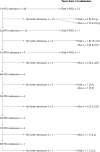Outcome of children with neuromuscular disease admitted to paediatric intensive care
- PMID: 14736637
- PMCID: PMC1719795
- DOI: 10.1136/adc.2002.019562
Outcome of children with neuromuscular disease admitted to paediatric intensive care
Abstract
Aims: To determine the outcome of children with neuromuscular disease (NMD) following admission to a tertiary referral paediatric intensive care (PICU).
Methods: All children with chronic NMD whose first PICU admission was between July 1986 and June 2001 were followed up from their first PICU admission to time of study. The outcomes recorded were death in or outside of PICU, duration of PICU admission, artificial ventilation during admission and following discharge from PICU, and readmission to PICU.
Results: Over 15 years, 28 children were admitted on 69 occasions. Sixteen (57%) children had more than one admission. The median duration of PICU admission was 4 days (range 0.5-42). Twenty three per cent of unplanned admissions resulted in the commencement of respiratory support that was continued after discharge from the PICU. Severity of functional impairment was not associated with longer duration of stay or higher PRISM scores. Ten children (36%) died, with four (14%) deaths in the PICU. A higher proportion of children with severe limitation of function were among children that died compared to survivors.
Conclusion: Most children with NMD admitted to the PICU recover and are discharged without the need for prolonged invasive ventilation. However, in this group of children, the use of non-invasive home based ventilation is common and they are likely to require further PICU admission.
Figures
Similar articles
-
Impact of Viral Respiratory Pathogens on Outcomes After Pediatric Cardiac Surgery.Pediatr Crit Care Med. 2017 Mar;18(3):219-227. doi: 10.1097/PCC.0000000000001083. Pediatr Crit Care Med. 2017. PMID: 28114162
-
Efficacy and outcome of intensive care in pediatric oncologic patients.Crit Care Med. 2001 Dec;29(12):2276-80. doi: 10.1097/00003246-200112000-00007. Crit Care Med. 2001. PMID: 11801824
-
Description of PICU Unplanned Readmission.Pediatr Crit Care Med. 2016 Jun;17(6):558-62. doi: 10.1097/PCC.0000000000000735. Pediatr Crit Care Med. 2016. PMID: 27261644
-
Patient origin is associated with duration of endotracheal intubation and PICU length of stay for children with status asthmaticus.J Intensive Care Med. 2014 May-Jun;29(3):154-9. doi: 10.1177/0885066613476446. Epub 2013 Feb 11. J Intensive Care Med. 2014. PMID: 23753230 Review.
-
Patient follow-up after discharge from the paediatric intensive care unit: A scoping review.Nurs Crit Care. 2025 May;30(3):e13187. doi: 10.1111/nicc.13187. Epub 2024 Oct 18. Nurs Crit Care. 2025. PMID: 39421878 Free PMC article.
Cited by
-
Children with chronic illness return to their baseline functional status after organ dysfunction on the first day of admission in the pediatric intensive care unit.J Pediatr. 2010 Jul;157(1):108-113.e1. doi: 10.1016/j.jpeds.2009.12.029. Epub 2010 Mar 10. J Pediatr. 2010. PMID: 20223474 Free PMC article.
-
All You Need Is Evidence: What We Know About Pneumonia in Children With Neuromuscular Diseases.Front Pediatr. 2021 Sep 1;9:625751. doi: 10.3389/fped.2021.625751. eCollection 2021. Front Pediatr. 2021. PMID: 34540761 Free PMC article. Review.
-
Evaluating treatment and care outcomes for neuromuscular diseases in a pediatric intermediate care setting.Front Pediatr. 2025 Apr 9;13:1539540. doi: 10.3389/fped.2025.1539540. eCollection 2025. Front Pediatr. 2025. PMID: 40270943 Free PMC article.
-
Characteristics and Outcomes of Young Adult Patients with Severe Sepsis Admitted to Pediatric Intensive Care Units Versus Medical/Surgical Intensive Care Units.J Intensive Care Med. 2023 Mar;38(3):290-298. doi: 10.1177/08850666221119685. Epub 2022 Aug 10. J Intensive Care Med. 2023. PMID: 35950262 Free PMC article.
-
Outcomes after critical care admission in people with a learning disability.J Intensive Care Soc. 2024 Dec 2;26(1):61-67. doi: 10.1177/17511437241301922. eCollection 2025 Feb. J Intensive Care Soc. 2024. PMID: 39635292 Free PMC article.

